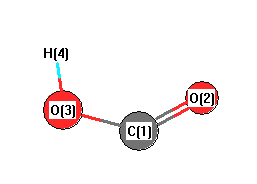Jump to
S1C2
Energy calculated at CCSD/aug-cc-pVTZ
| | hartrees |
|---|
| Energy at 0K | -188.820973 |
| Energy at 298.15K | -188.822067 |
| HF Energy | -188.208713 |
| Nuclear repulsion energy | 63.285000 |
The energy at 298.15K was derived from the energy at 0K
and an integrated heat capacity that used the calculated vibrational frequencies.
Vibrational Frequencies calculated at CCSD/aug-cc-pVTZ
| Mode Number |
Symmetry |
Frequency
(cm-1) |
Scaled Frequency
(cm-1) |
IR Intensities
(km mol-1) |
Raman Act
(Å4/u) |
Dep P |
Dep U |
|---|
| 1 |
A' |
3701 |
3537 |
38.75 |
|
|
|
| 2 |
A' |
1899 |
1815 |
338.22 |
|
|
|
| 3 |
A' |
1327 |
1268 |
0.10 |
|
|
|
| 4 |
A' |
1102 |
1053 |
196.21 |
|
|
|
| 5 |
A' |
613 |
586 |
33.69 |
|
|
|
| 6 |
A" |
573 |
548 |
110.75 |
|
|
|
Unscaled Zero Point Vibrational Energy (zpe) 4607.1 cm
-1
Scaled (by 0.9558) Zero Point Vibrational Energy (zpe) 4403.4 cm
-1
See section
III.C.1 List or set vibrational scaling factors
to change the scale factors used here.
See section
III.C.2
Calculate a vibrational scaling factor for a given set of molecules
to determine the least squares best scaling factor.
Geometric Data calculated at CCSD/aug-cc-pVTZ
Point Group is Cs
Cartesians (Å)
| Atom |
x (Å) |
y (Å) |
z (Å) |
|---|
| C1 |
0.000 |
0.441 |
0.000 |
| O2 |
-1.060 |
-0.360 |
0.000 |
| O3 |
1.154 |
0.189 |
0.000 |
| H4 |
-0.748 |
-1.279 |
0.000 |
Atom - Atom Distances (Å)
| |
C1 |
O2 |
O3 |
H4 |
| C1 | | 1.3287 | 1.1810 | 1.8758 |
O2 | 1.3287 | | 2.2811 | 0.9710 | O3 | 1.1810 | 2.2811 | | 2.4026 | H4 | 1.8758 | 0.9710 | 2.4026 | |
 More geometry information
More geometry information
Calculated Bond Angles
| atom1 |
atom2 |
atom3 |
angle |
|
atom1 |
atom2 |
atom3 |
angle |
| C1 |
O2 |
H4 |
108.303 |
|
O2 |
C1 |
O3 |
130.611 |
Electronic energy levels
Charges, Dipole, Quadrupole and Polarizability
Jump to
S1C1
Energy calculated at CCSD/aug-cc-pVTZ
| | hartrees |
|---|
| Energy at 0K | -188.823685 |
| Energy at 298.15K | -188.824757 |
| HF Energy | -188.209627 |
| Nuclear repulsion energy | 63.061082 |
The energy at 298.15K was derived from the energy at 0K
and an integrated heat capacity that used the calculated vibrational frequencies.
Vibrational Frequencies calculated at CCSD/aug-cc-pVTZ
| Mode Number |
Symmetry |
Frequency
(cm-1) |
Scaled Frequency
(cm-1) |
IR Intensities
(km mol-1) |
Raman Act
(Å4/u) |
Dep P |
Dep U |
|---|
| 1 |
A' |
3857 |
3686 |
128.78 |
|
|
|
| 2 |
A' |
1941 |
1855 |
252.26 |
|
|
|
| 3 |
A' |
1275 |
1219 |
250.33 |
|
|
|
| 4 |
A' |
1104 |
1055 |
74.69 |
|
|
|
| 5 |
A' |
628 |
600 |
5.01 |
|
|
|
| 6 |
A" |
531 |
508 |
84.57 |
|
|
|
Unscaled Zero Point Vibrational Energy (zpe) 4667.5 cm
-1
Scaled (by 0.9558) Zero Point Vibrational Energy (zpe) 4461.2 cm
-1
See section
III.C.1 List or set vibrational scaling factors
to change the scale factors used here.
See section
III.C.2
Calculate a vibrational scaling factor for a given set of molecules
to determine the least squares best scaling factor.
Geometric Data calculated at CCSD/aug-cc-pVTZ
Point Group is Cs
Cartesians (Å)
| Atom |
x (Å) |
y (Å) |
z (Å) |
|---|
| C1 |
0.000 |
0.406 |
0.000 |
| O2 |
-0.941 |
-0.549 |
0.000 |
| O3 |
1.166 |
0.259 |
0.000 |
| H4 |
-1.802 |
-0.119 |
0.000 |
Atom - Atom Distances (Å)
| |
C1 |
O2 |
O3 |
H4 |
| C1 | | 1.3410 | 1.1756 | 1.8765 |
O2 | 1.3410 | | 2.2570 | 0.9622 | O3 | 1.1756 | 2.2570 | | 2.9918 | H4 | 1.8765 | 0.9622 | 2.9918 | |
 More geometry information
More geometry information
Calculated Bond Angles
| atom1 |
atom2 |
atom3 |
angle |
|
atom1 |
atom2 |
atom3 |
angle |
| C1 |
O2 |
H4 |
107.995 |
|
O2 |
C1 |
O3 |
127.374 |
Electronic energy levels
Charges, Dipole, Quadrupole and Polarizability
